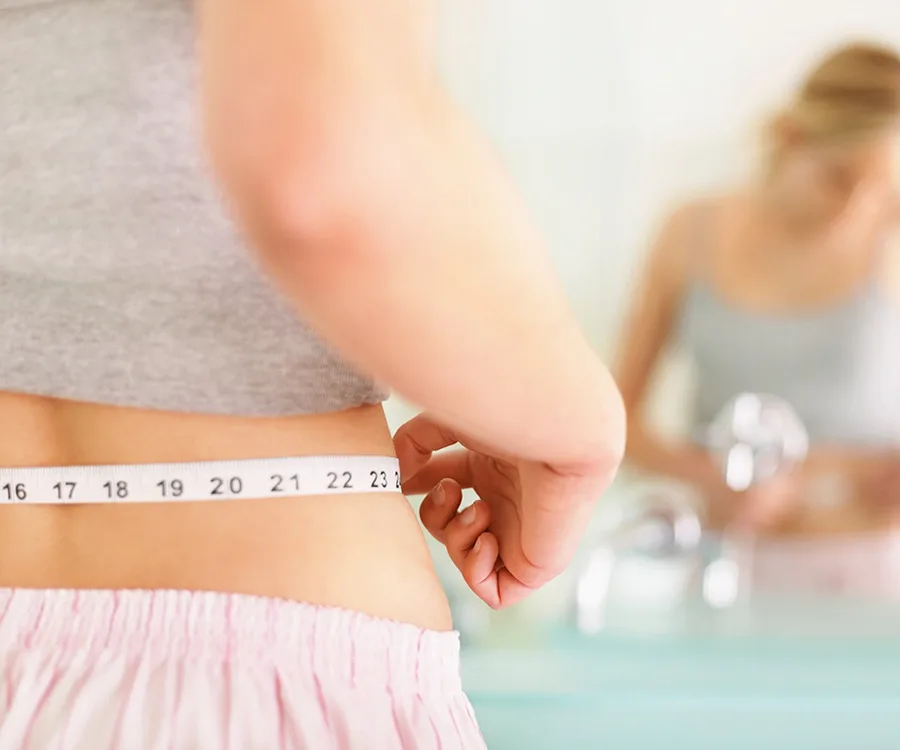Hormones are effectively chemical messengers that travel throughout your body coordinating complex processes such as growth, metabolism and fertility.
They are made by your endocrine glands – thyroid, pancreatic islets, adrenals, ovaries and pituitary – and can influence your immune system, growth, metabolism and behaviour.
Research has also discovered the link to these hormones and fat storage in different areas of the body. So having too much of one hormone could predispose you to storing fat on, for example, your stomach, upper arms or thighs.
“As children, boys’ and girls’ bodies are both straight up and down,” says women’s health expert Dr Marilyn Glenville. “But at puberty, levels of male and female hormones rise and dictate body shape. Some experts believe a range of other hormones, if they’re out of balance, can also impact where you store fat.”
Luckily, there are steps you can take to make changes to your shape by tailoring your diet and lifestyle.
The problem: Flabby arms
The hormone: Testosterone
“Testosterone isn’t exclusively a male hormone,” says Max Tomlinson, naturopath and author of Target Your Fat Spots. “Women produce small amounts in their adrenal glands and ovaries and it’s thought to contribute to muscle and bone strength, brain function and libido.”
If you don’t have enough, you may accumulate fat on the backs of your upper arms. “Men don’t have bingo wings because their higher testosterone helps them create lean arms,” says Tomlinson.
A woman in her 40s typically has just half the testosterone she had in her 20s, he explains. “After menopause, testosterone can drop dramatically. You may also notice fatigue and a low sex drive.”
The fix:
“High blood glucose decreases testosterone production, so keep levels in check by cutting sugar and refined carbs,” advises Tomlinson. Swap bread and pasta for wholemeal versions and avoid sugary foods.
- Increase omega-3s
“These healthy fats are required for testosterone production,” says Tomlinson. “Eat smaller oily fish, such as salmon, mackerel and sardines, at least once a week, and have white fish twice a week – these contain some omega-3s but in smaller amounts. Top up with flaxseed – add a spoonful to muesli or porridge.”
- Lift weights
“Weight-bearing exercise uses the body’s own weight to place pressure on bones and muscles, which causes the muscles to signal cells for more energy and to request more testosterone for this,” says Tomlinson.
Hit the weights section in the gym three times a week.
WATCH What kind of dieter are you? Article continues after video…
The problem: A big bum
The hormone: Oestrogen
“This female hormone drives the storage of fat around the hips and thighs in women of childbearing age, so it’s natural to have a pear shape,” says Dr Glenville.
“But it is possible to have too much oestrogen. Along with more fat on the hips and thighs, heavy periods can be a sign. Having large breasts can also be an indicator, as breast growth is driven by this hormone.”
The fix:
- Go organic
“While some women naturally produce more oestrogen than others, foreign oestrogens found in pesticides, plastics and some cosmetics can add to the load,” says Dr Glenville.
These chemicals act as ‘endocrine disruptors’, causing unwanted chemical changes in your body. Some bind to hormone receptor cells and send false signals, while others block the action of the natural hormone, stopping it binding to its receptor and having its intended effect.
“It’s hard to avoid these chemicals completely, but choosing organic foods and avoiding packaged, processed foods will help reduce your exposure,” says Dr Glenville.
If it’s not possible to eat an entirely organic diet, the US’s Environmental Working Group advises you at least choose organic soft berries and salad leaves, as non-organic versions more easily absorb pesticides and preservatives used than food with a tough skin, which you can remove, such as bananas and avocados.
- Take a probiotic
“Oestrogen is drawn out through the bowel but if it isn’t carried out properly, due to sluggish digestion, it can end up recirculating, which also adds to the oestrogen load in your body,” says Dr Glenville.
One way to maintain an efficient bowel is to take probiotics, as studies have shown they decrease transit time of food in the gut. “They will help balance levels of friendly bacteria in your gut, improving your digestion,” says Dr Glenville.
“Increasing fibre intake could help,” she adds. “Try porridge for breakfast, as oats are high in soluble fibre, which is more soothing on your digestive system than cereal grains such as bran.”
She also recommends flaxseed as it absorbs water and forms a soothing gel-like substance to aid the passage of stools. Soak a teaspoon of seeds in water overnight and drink the mixture the next morning, when it has turned into a jelly.
A word of caution: some gastroenterologists have advised people with IBS not to increase fibre as they say it can worsen symptoms.
- Load up on B vitamins
“They can help convert excess oestrogens into weaker forms,” says Dr Glenville. Eat lots of green leafy vegetables and wholegrains.
WATCH This man’s mind-blowing body transformation. Article continues after video…
The problem: Pot belly
The hormone: Cortisol
“Cortisol is released under stress,” says Dr Glenville. “It releases sugar into the bloodstream, ready for us to run or fight, activities which would use up the sugar.
But nowadays, we’re under chronic, low-level stress, from sitting in traffic jams or fielding lots of emails. This means cortisol is constantly being released, leading to consistently raised blood sugar.
“The sugar has to be stored somewhere, and because the presence of cortisol makes the body think a threat is present, it stores it as fat around the middle of the body, where it can be accessed quickly.”
The other problem is when you’re stressed, you’re more likely to reach for sugary snacks in a bid to raise your energy. This reinforces the problem, as the blood sugar roller-coaster can further exacerbate stress.
The fix:
- Try ‘nature’s tranquilliser’
Look for foods rich in magnesium such as leafy greens, bananas and yoghurt. “Magnesium helps your body deal with stress and relaxes muscles,” says Dr Glenville.
- Get more sleep
Research has found that a lack of sleep leaves you with higher levels of cortisol by the following evening, so aim for a solid eight hours. Having trouble nodding off? Try the free Sleepio app, which uses cognitive behaviour therapy techniques to beat sleep problems.
- Switch to herbal teas
“Caffeine can trigger cortisol release, so stick to one caffeinated drink a day,” says Dr Glenville. “Instead, try calming herbal teas like chamomile.”
WATCH Ask the doctor: How your diet can help make you look younger. Article continues after video…
The problem: Muffin top
The hormone: Insulin
The job of insulin is to move glucose from the bloodstream into your body’s cells to be used as fuel. Excess glucose is stored as glycogen in your liver cells.
“Insulin levels rise as we get older, particularly if your diet is high in refined carbohydrates and this can lead to more fat storage around the hips,” says Tomlinson.
High insulin levels can result in insulin resistance, when your body’s cells can’t use the hormone effectively. “Women with polycystic ovary syndrome (PCOS) are insulin resistant and that’s why it’s associated with having a muffin top,” says Dr Glenville.
Over time, insulin resistance can raise your risk of type 2 diabetes.
The fix:
- Eat little and often
“This helps keep blood glucose levels steady,” says Dr Glenville. “Have snacks in the morning and afternoon, but go for foods low on the glycaemic index, which release energy more steadily.”
Try an apple with a small piece of cheese.
- Add cinnamon
A US meta-analysis found a teaspoon of cinnamon helped lower blood glucose levels, even in people with type 2 diabetes.
Add a teaspoon to your breakfast cereal or smoothies.
- Take chromium
This mineral helps level out blood sugar.
The problem: Bra bulge
The hormone: Thyroid hormones
Situated in the neck, the thyroid gland secretes the hormones triiodothyronine (T3) and thyroxine (T4), which control how quickly your body burns kilojoules and uses energy.
“It’s hard to lose weight anywhere if your thyroid is underactive, but my female clients with low thyroid function very often have fat deposits under the armpits,” says Tomlinson.
The fix:
- Cut out anti-thyroid foods
“Goitrogens are substances in food that can compromise the production of thyroid hormones,” says Tomlinson.
“Limit your intake of food that contains them including broccoli, Brussels sprouts, cabbage, peaches and peanuts.”
- Meditate
“Stress can alter thyroid metabolism,” says Tomlinson. A Canadian study has found that mindfulness meditation can help ease stress – try the free Calm app, which takes you through guided meditations.
- Choose quality cooking oils
“Standard cooking oils, such as sunflower oil, can interfere with thyroid function,” says Tomlinson.
“Focus mainly on olive oil.”
Extra-virgin olive oil is best as a dressing. For cooking choose light olive oil, for its higher smoke point – it can be heated to a higher temperature without degrading and forming harmful free radicals.
The tests to have
Your GP can test levels of thyroid hormones and can check your blood glucose levels, which can indicate how well your body’s responding to insulin. They can also refer you for hormone tests if you have symptoms of PCOS or are having fertility problems.


